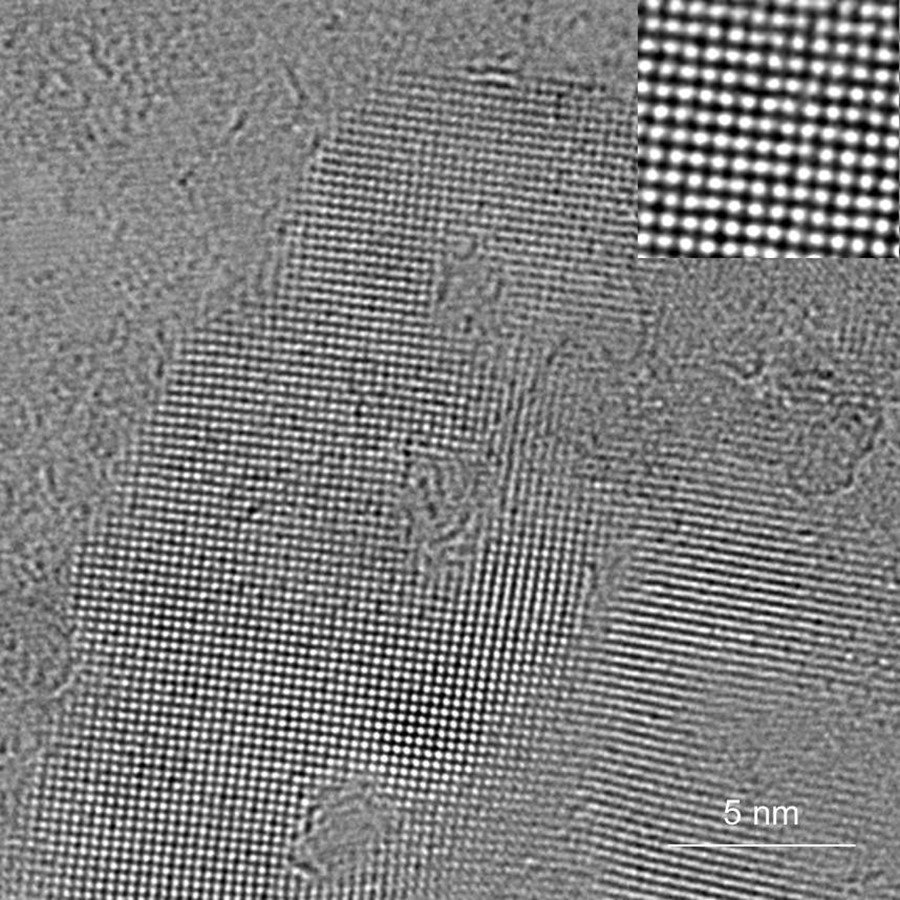Square ice filling for a graphene sandwich
Graphene Flagship scientists observe square ice crystals between graphene layers brought together under ultra-high pressures generated by atomic interactions. The finding could lead to a better understanding of water flow through nanoscale channels and across membranes.
Water exists in myriad forms, and for poets and scientists alike this structurally simple yet at the same time behaviourally complex molecule never fails to fascinate. In our everyday lives we are familiar with water in its more common liquid, ice and vapour forms. Scientists also study water under more extreme conditions, including at high pressures, where it can exist in the solid state even at room temperature.
Ice crystals form in the beautifully symmetric tetrahedral shapes seen in snowflakes and on the surface of frozen ponds. Such geometries can persist at very high pressures, even if the underlying structure undergoes phase changes both subtle and dramatic with varying pressure. This certainly applies to unconstrained water. When confined between other materials, however, the behaviour of water is influenced by atomic interactions with material surfaces. The more usual ice crystals can then morph into something quite different.
When water is confined at high pressure between sheets of graphene – a single-atom-thick arrangement of carbon atoms in a hexagonal lattice – its molecules adopt a square configuration. This is the surprise finding of researchers in Germany, the UK and China.
Published in the leading science journal Nature, the results of the study, funded in part by the Graphene Flagship, could improve our understanding of water transport through nanometre-scale channels in natural and artificial membranes. For example, the aquaporin protein-mediated flow of water across biological cell membranes is down to a balance between hydrophobic and hydrophilic interactions with channel surfaces. Such interactions are dependent on chemical bonds between hydrogen atoms.
With graphene ‘pores’ the situation is different, in that the cross section is planar rather than circular. Also, the pressure exerted on the water is so high that hydrogen bond interactions with the graphene surface are overcome by the attractive van der Waals atomic interaction that draws together the graphene planes. Still, the comparison is pertinent, and should add to the scientific debate around water flow through nanoscale channels and across membranes.
Ulm University physicists Gerardo Algara-Siller and Ossi Lehtinen carried out the latest experiment, in which a graphene monolayer was first deposited on an electron microscope grid. This graphene layer was then exposed to a small amount of water, and covered with another layer of graphene. Much of the water was squeezed out of the graphene sandwich by the van der Waals force; the remainder was trapped in pockets less than a millionth of a metre across.
“Gerardo Algara-Siller and Ossi Lehtinen carried out the experiment, and imaged the unknown ice structure between graphene sheets,” said Ulm University professor Ute Kaiser, who led the German side of the collaboration.“We did not know at first what we were seeing, and only in discussion with our Manchester colleagues was the idea of square ice born. A detailed structural and elemental analysis then proved this structure to be real.”
The Manchester connection is significant, not least owing to participation in the research by Irina Grigorieva, who has a special interest in molecular and particle transport across membranes formed of layered materials such as graphene. Scientists have long sought to understand the structure and behaviour of water confined within narrow channels. The study has until now only been possible in computer simulations, the results of which seldom agree with each other.
Grigorieva’s Manchester colleague Andre Geim, who shared the 2010 Nobel Prize in Physics for his pioneering work on graphene, is another co-author of the new Nature paper. Geim and others had previously speculated that observations of ultrafast water flow through graphene nanocapillaries could be due to two-dimensional square ice. The new research appears to confirm the hypothesis, even if the detailed origins of this strange structure remain a mystery.
Further reading
Algara-Siller et al., Square ice in graphene nanocapillaries, Nature 519, 443 (2015). DOI: 10.1038/nature14295.
Alan K Soper, Square ice in a graphene sandwich, Nature 519, 417 (2015).
Video: www.youtube.com/watch?v=TFL_4riM1PA

Square ice between two graphene sheets as seen in a transmission electron microscope. High-contrast dark spots are oxygen atoms that indicate positions of water molecules. Hydrogen atoms yield too little contrast to be resolved even by the state-of-the-art TEM. The top right inset shows a magnified image of a small area in the centre of the ice crystal (copyright 2015 Universität Ulm).

Gerardo Algara-Siller

Ossi Lehtinen



